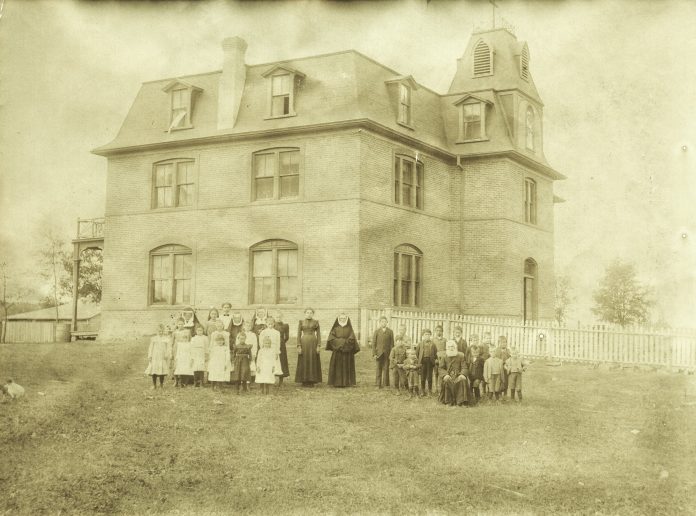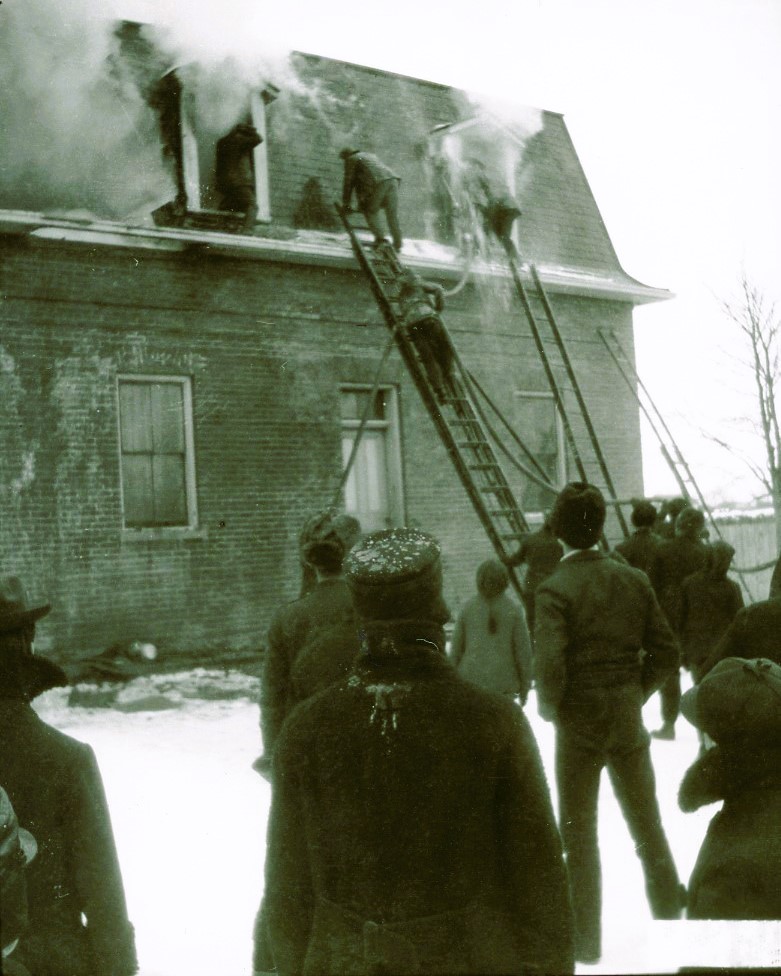
A Brief History of St. Patrick’s Catholic Orphanage
Through this column, you have met several of the 70 British Home Children who lived at St. Patrick’s Catholic Orphanage in Prince Albert in the early 1900s. There are still a few more children’s stories to tell, but I’d like to tell you a bit about the history of the institution.
In 1899, the abandoned former Convent of the Faithful Companion of Jesus (also known as St. Anne’s Convent) was purchased by Bishop Albert Pascal OMI (Oblates of Mary Immaculate) and converted into the home of St. Patrick’s Orphanage. An Oblate priest from Germany, Father William Brueck, was the director of the institution from the time of its founding until his death in 1947. There were originally seven local children but after it officially opened on 18 April 1900, the number of children at the orphanage grew rapidly.
The driving force behind the growth in the number of children and a key figure in the operation of the orphanage was Brother Edouard Marie Courbis OMI (1865-1942). During the winter of 1900-1901, Brother Courbis contacted the authorities of the Catholic Emigration Society in England and was instrumental in bringing seventy British children to Prince Albert in three groups sent in 1901, 1903, and 1907. This transfer of impoverished children from overseas was financially motivated. In exchange for assuming responsibility for the children, the orphanage was paid $11,000. This money was used to add two wings to the orphanage building.
Conditions at St. Patrick’s Catholic Orphanage, located on a block between Fifteenth and Thirteenth Streets West in Prince Albert, were not great in its early years. Quite simply, the institution was not prepared for children. “There was no money and means of financing the institution was overlooked,” writes Monica H. Plante, author of a history of the orphanage (1988). “It was taken for granted that Divine Providence would care for the needs of the children.”
Over the years, Father Brueck and Brother Courbis made many appeals for material and financial support in letters to newspapers in Canada, the United States and the United Kingdom such as the Catholic Union and Times. For example, “If you knew, as we do, the pitiful circumstances of these poor forsaken little ones of Christ, you would be moved to tears,” Courbis wrote to the Irish Standard on 25 November 1905.

Prince Albert Fire Department fighting the blaze at the orphanage, 1 February 1947.
In February 1906, a fire all but destroyed the newly constructed wing which housed the boys’ dormitory and classrooms for the orphanage. Brother Courbis renewed his appeals for financial assistance. “The insurance is very small, and is far from covering the heavy losses. Still the home has to be rebuilt as soon as possible. Who shall help us to do so?” Courbis wrote to the readers of the Irish Standard on 10 March 1906. “[N]ever has our distress been greater than today. All is gone, not even a blanket is left. … I do not ask you to help us in building a house with every possible comfort. No! All I want is a shelter for our children.”
Brother Courbis’ appeal must have been successful, for on 14 November 1906 he wrote again to the Irish Standard stating that the response had been “both noble and generous.” The February fire “threw us far back on our progressive path,” however Courbis was happy to report that “although our Orphanage is still standing on but a very weak basis, it is on the way to prosperity.”
Part of the reason for Brother Courbis’ optimism was the newly established orphanage farm, set up in 1903-1904 in the White Star district north of Prince Albert. Brother Courbis strongly believed that a farm would set St. Patrick’s Orphanage on a self-sustaining financial footing. The story of the orphanage farm was the subject of a previous “Shattered Lives” article.
The Sisters of Providence came from France in 1901 to teach the children at St. Patrick’s, but because they could not speak English, the children were required to speak French. It was not until July 1906 that three English-speaking Sisters of Charity arrived from New Brunswick to teach the orphanage children. After 1926 there were eight Sisters, by 1936 there were eleven Sisters, and in 1947 at the time of the fire there were fifteen.
School at the orphanage only lasted until Grade 8. After that, the boys either worked on Brother Courbis’ farm project or went to St. Louis or Muenster, Saskatchewan to continue their education. The girls could go on to Sion Academy in Prince Albert.
St. Patrick’s Catholic Orphanage, officially incorporated on 24 June 1915, was forced to raise its own funds because there was no government funding. The City of Prince Albert was apparently unwilling or unable to provide financial assistance. In early 1916, Father Brueck asked the City for a tax exemption on the land on which the orphanage stood. A motion was passed at City Council on 5 March 1916 authorizing the finance committee to meet with Father Brueck to discuss the matter, “but the opinion of some members of council seemed to be that the orphanage was being well treated.” Mayor Knox asked “who would pay the piper if the council exempted whole blocks of land.” Alderman Muir said he “did not think it fair to exempt a corporation and put the burden on the individual taxpayer.” The City declined to grant tax exemption on Orphanage land that year and again in 1925. [Prince Albert Daily Herald, 6 March 1916 and 17 March 1925]
The Government of Saskatchewan under Premier Walter Scott was unwilling to grant support for the orphanage. Provisions for social welfare during the first years after Saskatchewan became a province in 1905 were under the control of the Department of Agriculture. In 1906, the department refused a government grant to the St. Patrick’s Orphanage, determining that the orphanage did not fall under the heading of “institutions” and was, therefore, not eligible.
In his response to Father Brueck’s appeal for funding in January 1909, Premier Walter Scott wrote that public institutions like orphanages destroyed the sense of responsibility of a child and “he is sent out into the world with no initiative and no real ability to do for himself.” It was not until 1920 that St. Patrick’s received a grant of $2000 from the Province to assist in the education of the 87 children under its care. [Source: Kimberly Anne Marschall, “Raising Juvenile Delinquents: The Development of Saskatchewan’s Child Welfare Laws, 1905-1930.” Masters thesis, University of Saskatchewan 2003.]
Funds for the orphanage came primarily from drives organized by the Knights of Columbus. For example, every St. Patrick’s Day the Catholic service club held a Shamrock Sale with proceeds going to St. Patrick’s.
“In 1924, 84 children were cared for at the Orphanage but there were 52 others not admitted due to lack of room,” Sister Monica Plante writes (1988). “St. Patrick’s in Prince Albert served the western area in caring for homeless children and sometimes boarding those whose homes were so remote that they had to live in the city to receive a good education, especially a high school education.”
Just after 2:00 a.m. on 1 February 1947, a fire broke out in St. Patrick’s Catholic Orphanage. Although the mercury stood at 45 degrees below zero, residents along Thirteenth and Fifteenth Streets West rushed to the aid of 122 children and 18 staff members as they stumbled from the orphanage, many barefooted and clad only in their pajamas. As the building roared in flames, citizens helped the children make the 300-yard-dash across the street to the warmth and safety of Holy Family Hospital. Not all escaped, however. Seven perished in the fire – six young girls and one of the sisters who cared for the children.
The Knights of Columbus were instrumental in the rebuilding of St. Patrick’s Orphanage after the disastrous fire. The new $270,000 facility was opened in November 1951 at Seventeenth Avenue West in the city.
The orphanage closed in June 1973. In his announcement of the closure, Father Clifford J. Tremblay, Director of the Catholic Orphanage, wrote, “Great strides were being made in the understanding of human behaviour, and these proved that care in orphanages was not always the answer to cases of children forced to live apart from their parents.” – As quoted in Plante.
My main source for this history is Sister Monica Plante’s book, St. Patrick’s Catholic Orphanage, 1903-1973, Prince Albert, Saskatchewan, 1988. Copies can be found at the Bill Smiley Archives at the Prince Albert Historical Museum, the Prince Albert Public Library, the Roman Catholic Diocese of Prince Albert, and online at Local Histories Collection, Libraries and Cultural Resources Digital Collections, University of Calgary.

